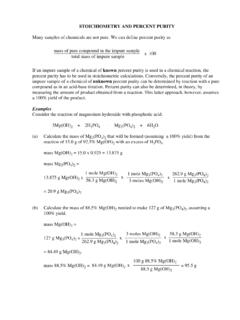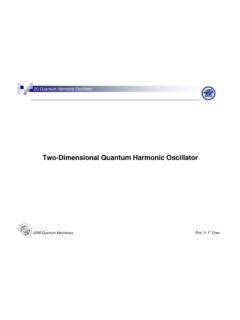Transcription of Physics 1120: Simple Harmonic Motion Solutions
1 Questions: 1 2 3 4 5 6 7 8 9 10 11 12 13 14 15 16 Physics 1120: Simple Harmonic Motion Solutions1. A kg particle moves as function of time as follows:x = 4cos( + /5)where distance is measured in metres and time in seconds. (a) What is the amplitude, frequency, angular frequency, and period of this Motion ? (b) What is the equation of the velocity of this particle? (c) What is the equation of the acceleration of this particle?(d) What is the spring constant? (e) At what next time t > 0, will the object be: i. at equilibrium and moving to the right,ii. at equilibrium and moving to the left,iii. at maximum amplitude, andiv. at minimum amplitude.(a) First write the general expression on top of the given expressionx = Acos( t + 0 )x = 4cos( + /5)Immediately, we get A = 4 m, = rad/s, and 0 = /5.
2 Since = 2 / T = 2 f, we get T = 2 rad/s = s,and f = / 2 = s 1. (b) The velocity is given by the first derivative of position with respect to timev = Asin( t + 0) .With the given values, we getv = ( + /5) .(c) The acceleration is given by the second of position with respect to time, or the first derivative of the velocity with respectto time,a = 2A cos( t + /5) .With the given values, we geta = ( + /5) .(d) We have the relation that 2 = K/m, soK = 2m = ( rad/s)2( kg) = N/m .(e) (i) & (ii) We know that at equilibrium x = 0. We also know that there are two places where this happens, one where is thevelocity is positive and the object is moving to the right, and one where the velocity is negative and the object is moving to theleft.
3 So first let's set x = 0,0 = 4cos( t + /5) .We can divide through by 4, and we get 0 = cos( t + /5) .Taking the inverse of both sides, the solution is t + /5 = cos 1(0) ,and thus, t = [cos 1(0) /5] / .Now cos 1(0) has many Solutions , all the angles in radians for which the cosine is zero. This occurs for angles = /2, = /2, = 3 /2, = 3 /2, and so on. This is usually expressed = n /2, where n = 1, 3, 5, ..So our Solutions for t are in the formt = [n /2 /5] / , where n = 1, 3, 5, ..The first nonzero time when x = 0 occurs for n = +1,t1 = [ /2 /5] / = second nonzero time occurs when n = +2,t2 = [3 /2 /5] / = tell which has the object moving to the right and which to the left we examine the velocity v1 = ( + /5) = ( /2) = m/s,v2 = ( + /5) = (3 /2) = + see that the object is moving to the left, has negative velocity, at t = t1 = s, and is moving to the right at t = t2 = s.
4 (iii) At maximum amplitude, x = +4, so we have4 = 4cos( t + /5) .Dividing through by 4, we get1 = cos( t + /5)Taking the inverse of both sides, the solution is t + /5 = cos 1(1) ,and thus, t = [cos 1(1) /5] / .Now cos 1(1) has many Solutions , all the angles in radians for which the cosine is plus one. This occurs for angles = 0, =2 , = 2 , = 4 , = 4 , and so on. This is usually expressed = 2n , where n = 0, 1, 2, 3 , ..So our Solutions for t are in the formt = [2n /5] / , where n = 0, 1, 2, 3, ..The first nonzero time when x = +4 occurs for n = +1,t = [2 /5] / = s.(iv) At minimum amplitude, x = 4, so we have 4 = 4cos( t + /5) .Dividing through by 4, we get 1 = cos( t + /5).
5 Taking the inverse of both sides, the solution is t + /5 = cos 1( 1) ,and thus, t = [cos 1( 1) /5] / .Now cos 1( 1) has many Solutions , all the angles in radians for which the cosine is negative one. This occurs for angles = , = , = 3 , = 3 , and so on. This is usually expressed = n , where n = 1, 3, 5, ..So our Solutions for t are in the formt = [n /5] / , where n = 1, 3, 5, ..The first nonzero time when x = 4 occurs for n = +1,t = [ /5] / = answers for (e) are thus(i)t = s,(ii)t = s,(iii)t = s, and(iv)t = Quicker Method Using Reference CircleAn alternate way of solving this problem is to consult the reference circle for a particle undergoing uniform circular motionwith radius A.
6 The x component of the particle's position, tangential velocity, and centripetal acceleration obey the equationsof SHM. At t = 0, the reference circle looks like the top diagram (a) shown below. Note that the x components of the vectorindicates that at t = 0, x(0) > 0, v(0) < 0, and a(0) < as we rotate counterclockwise with increasing time, there are four points of interest labelled 1, 2, 3, and 4 in thediagrams. These are the points where the object is farthest to the right, moving to the left through equilibrium, farthest to theleft, and moving to the right through equilibrium object on the spring, or equivalently the particle undergoing UCM, passes through points 2, 3, 4, and 1 in that are shown as times t1, t2, t3, and t4 in diagrams (b), (c), (d), and (e) in the figure figure (b) reference circle is for v = A.
7 We have rotated from the t = 0 position of /5 to /2 an angle of 90 36 =54 . Since a 360 rotation takes one period T, then the time required to get to here was given by the ratio t1/T = 54 /360 .Solving we find t1 = 54/360 s = figure (c) reference circle is for x = A. We have rotated from the t = 0 position of /5 to an angle of 180 36 =144 . Since a 360 rotation takes one period T, then the time required to get to here was given by the ratio t2/T = 144 /360 .Solving we find t2 = 144/360 s = figure (d) reference circle is for v = + A. We have rotated from the t = 0 position of /5 to 3 /2 an angle of 270 36 = 234 . Since a 360 rotation takes one period T, then the time required to get to here was given by the ratio t3/T =234 /360.
8 Solving we find t3 = 234/360 s = figure (e) reference circle is for x = +A. We have rotated from the t = 0 position of /5 to 2 an angle of 360 36 =324 . Since a 360 rotation takes one period T, then the time required to get to here was given by the ratio t2/T = 324 /360 .Solving we find t4 = 324/360 s = answers for (e) are thus(i)t = s,(ii)t = s,(iii)t = s, and(iv)t = If the amplitude in Question #1 is doubled, how would yours answers change? Simple Harmonic Motion is independent of amplitude. Our answers to Question #1 would not What are the equations for the potential and kinetic energies of the particle in Question #1? What is the total energy?The potential energy is spring potential energy and is given by U = Kx2, soU = ( )[4cos( + /5)] 2 = ( + /5).
9 The kinetic energy is given by K = mv2, soK = ( )[ ( + /5)] 2 = ( + /5) .The total energy is the sum of potential and kinetic energies,E = U + K = J .4. The diagram below shows the Motion of a kg mass on a horizontal spring. Draw the reference circle. Find the phaseconstant. Write down the equation of the displacement as a function of time. What is the spring constant? What is the totalenergy? What is the maximum speed? What is the maximum acceleration? When exactly will the mass be at equilibrium andmoving to the right? When exactly will the mass be at point C?Examining the graph we see that the largest displacement is 10 cm, so A = m. We also see that the Motion repeats seconds, so T = s. Angular frequency is related to the period by = 2 /T, so = 10.
10 At t = 0, we can read from the side of the graph that x = cm = m. The negative x position puts the object ateither quadrant II or III of the reference circle. To decide which quadrant is correct, note that as t increases the curve goesthrough zero (equilibrium), labelled point A in the diagram, and it is moving from negative to positive position so it is moving tothe right. This is the behaviour of the particle in quadrant III, so the reference circle looks likeWe can take the general equation, x = Acos( t + 0) and substitute in the t = 0 values to find 0. = (0 + 0) ,which reduces to = cos( 0) ,or 0 = cos 1( ) .Remember that your calculator will only give you one answer but there is also a second answer 360 minus thecalulator yields ( rad) or ( rad).










